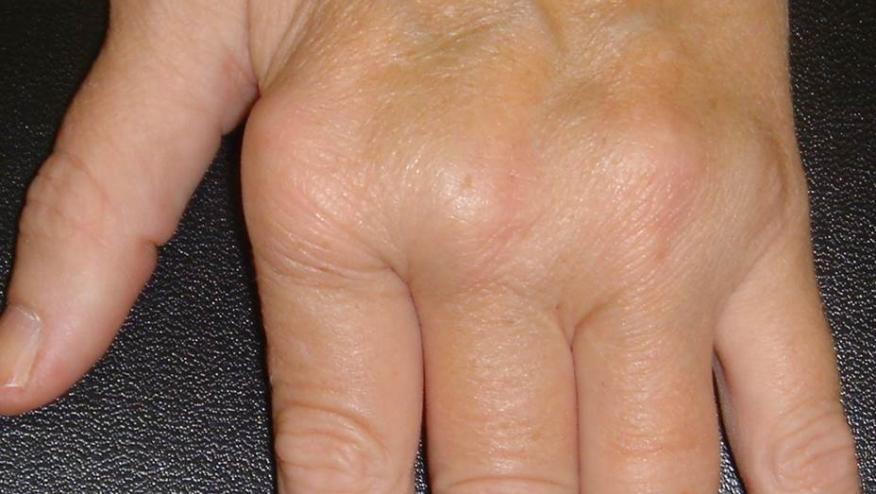RA Flares Common After Anti-TNF Withdrawal Save

The risk of a flare increased by more than three-fold over 1 year when patients with longstanding rheumatoid arthritis (RA) in remission, or with stable low disease activity, stopped their anti-tumor necrosis factor (TNF) treatment, Dutch researchers reported.
Among patients who stopped their anti-TNF therapy, 51.2% experienced a flare within 12 months compared with 18.2% (P<0.001) of those who continued, according to Marjan Ghiti Moghadam, MD, of the University of Twente in Enschede, and colleagues.
Accordingly, the hazard ratio for flare was 3.50 (95% CI 2.60-4.72), the researchers reported online in Arthritis & Rheumatology.
The trial did offer some encouragement for the possibility of stopping TNF inhibitor therapy in RA patients with remission or stable low disease activity, according to the authors. "Although patients in the stop group were clearly at increased risk of experiencing a flare within 12 months, the finding that even in patients with established RA almost half could stop TNF inhibitor treatment could be considered a promising result," they wrote.
But a more cautionary view was offered by Eric Matteson, MD, chair of rheumatology at the Mayo Clinic in Rochester, Minn.
He said that the importance of the study lies in the revelation that most RA patients will have recurrent disease activity after stopping therapy, even in patients who achieve remission or very low disease activity.
"In my view, RA is a chronic disease, which like hypertension, requires chronic, and for most patients, lifelong therapy," Matteson told MedPage Today.
Interest has been growing in the possibility of tapering or stopping biologic treatment among RA patients once remission occurs, but current recommendations provide little guidance on this, and previous studies have had conflicting results.
"Because of the potentially avoidable risks and expenses of long-term TNF inhibitor treatment, we undertook a nationwide pragmatic, randomized, multicenter, open-label controlled trial to examine whether established RA patients with remission or stable low disease activity can safely and effectively stop TNF inhibitors," Moghadam and colleagues wrote.
The study included 817 patients who had used a TNF inhibitor for at least 1 year and stable doses of conventional disease-modifying anti-rheumatic drugs for at least 6 months.
Patients were in remission, defined as a disease activity score in 28 joints (DAS28) below 6.2, or had low disease activity, which was a DAS28 below 3.2, for at least 6 months. Alternatively, patients could be considered stable based on rheumatologists' clinical impression in combination with a baseline DAS28 below 3.2 and at least one C-reactive protein (CRP) level below 10 mg/L in the 6 months prior.
A flare was defined as a DAS28 score of 3.2 or higher with an increase of 0.6 or more compared with the baseline DAS28.
Patients' mean age was 60, and mean disease duration was 12 years. Two-thirds were seropositive, and almost as many had erosive disease. The most common anti-TNF agents being used were adalimumab (Humira) and etanercept (Enbrel).
More than 80% also were taking methotrexate.
Among patients who stopped their TNF inhibitor, the proportion that experienced a flare within 12 months was similar between the group that was included based on available DAS28 scores compared with those that were included based on the rheumatologists' clinical impression plus CRP (51.2% versus 51.5%, respectively,P=0.944).
There was no significant difference in time to flare by the type of TNF inhibitor that was stopped (P=0.691).
Among all patients in remission at baseline, 127 of 428 (29.7%) in the stop group compared with 128 of 225 (56.9%) in the continuation group (P<0.001) remained in DAS28 remission throughout the 12-month study period.
Independent predictors of shorter time to flare other than stopping the anti-TNF treatment were higher baseline DAS28 scores (HR 1.39, 95% CI 1.21-1.60) and disease duration of more than 10 years (HR 1.29, 95% CI 1.03-1.61).
Post-hoc analyses revealed that DAS28 scores were significantly higher at all follow-up time points in the group that stopped their TNF inhibitor (P<0.001 for all), but in both groups, mean DAS28 scores remained below the threshold for moderate disease activity.
Restarting a TNF inhibitor after a flare resulted in quick re-establishment of remission or low disease activity, the researchers noted.
Of the 195 patients who restarted a TNF inhibitor after a flare during the first 6 months, 67.7% again were in clinical remission and another 16.9% had low disease activity within 26 weeks. The median time to regaining low disease activity was 12 weeks, and 14 weeks for remission.
The stop group experienced more hospitalizations than the continuation group (6.4% versus 2.4%, P=0.012), but "there were no notable safety issues associated with stopping and restarting TNF inhibitors," the authors observed.
The open-label design and the short follow-up were two potential study limitations.
The study was funded by the Netherlands Organization for Health Research and Development/Government of The Netherlands, and Ministry of Health, Welfare, and Sport. Moghadam and co-authors disclosed no relationship with industry.
This article brought to RheumNow by our friends at MedPage Today. It was originally published February 17, 2016.









If you are a health practitioner, you may Login/Register to comment.
Due to the nature of these comment forums, only health practitioners are allowed to comment at this time.